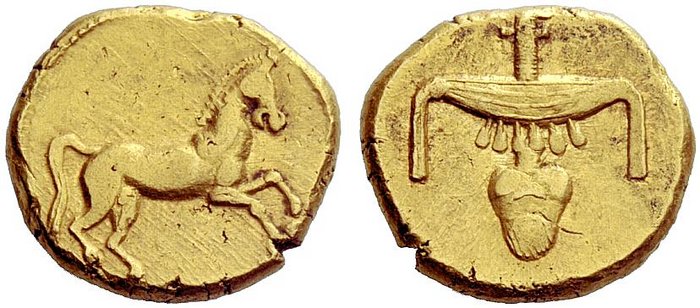S 1574 - Memphis (Nectanebo II), gold, darics (360-342 BCE)
From SILVER
360 BCE - 342 BCE Gold 4,930 kg
Description
| ObverseInscription or printing placed on the obverse.: | Horse prancing r. |
| ReverseInscription or printing placed on the reverse.: | Two hieroglyphs: collar with six beads (nub = gold), heart and windpipe (nefer = good). |
Mint and issuing power
| MintIdentifies the place of manufacture or issue of a numismatic object.: | Memphis | Ancient regionAncient region.: | Egypt | Modern countryModern country: Egypt | AuthorityIdentifies the issuing power. The authority can be "pretended" when the name or the portrait of X is on the coin but he/she was not the issuing power. It can also be "uncertain" when there is no mention of X on the coin but he/she was the issuing power according to the historical sources: |
Chronology
| FromIdentifies the initial date in a range assigned in a numismatic context. | 360 BCE | toIdentifies the final date in a range assigned in a numismatic context.. | 342 BCE | PeriodTime period of the numismatic object.: Classical 480-323 BC |
Physical description
| MetalThe physical material (usually metal) from which an object is made.: | Gold |
Median weightMedian of the weights of numismatic objects (in grams). in grams | 8.30 | DenominationTerm indicating the value of a numismatic object. Examples: tetradrachm, chalkous, denarius.: | daric | StandardStandard.: | Persic |
Image

S1574 Nefer Nub.jpg [1]
References
| Die study referencePublication of the study: | Faucher - Fischer-Bossert - Dhennin 20121Faucher - Fischer-Bossert - Dhennin 2012 | ||
| Coin series referenceReference to coin series study: | |||
Obverse dies distribution
| FrequencyFrequency of specimen in distribution. ᵖ | Number of obversesNumber of obverse dies. ᵖ (o) | % (o) | Number of coinsNumber of coins. (n) | % (n) | Die nameName(s) of the die(s). |
| 1 | 1 | 33.33 | 1 | 2.38 | 3 |
| 5 | 1 | 33.33 | 5 | 11.9 | 2 |
| 36 | 1 | 33.33 | 36 | 85.71 | 1 |
| Total | 3 of 3 | 99.99 | 42 of 42 | 99.99 |
Reverse dies distribution
no distribution is available
Quantification
| Number of obversesNumber of obverse dies. ᵖ (o) | 3 | Number of singletons (o1)The number of singleton coins. ᵖ | 1 |
| Number of reverse diesNumber of reverse dies. (r) | 3 | Number of coinsNumber of coins. (n) | 42 |
| Coins per obverse dieNumber of coins per obverse die. (n/o) | 14 | Coins per reverse dieNumber of coins per reverse die. (n/r) | 14 |
| Reverse per obverse ratioRatio of obverse dies divided by reverse dies. (r/o) | 1 | Percentage of singletons (o1)number of coins (n) divided by the number of singletons (o1) ᵖ | 33.33 % |
| Original number of dies (O) (Carter 1983 formula)The estimation of the number of coins according to Carter 1983 ᵖ | 2.97 | Coins struck if 20,000 as average productivity per dieCoins made if the average productivity for obverses (according to Carter) is 20,000. ᵖ | 59,400 |
| Original number of dies (O) (Esty 2011 formula)The estimation of the number of coins according to the singleton formula in Esty 2011 ᵖ (O) | 3.23 | Survival rate if 20,000 as average productivity per dieSurvival rate if average productivity is 20,000. ᵖ | 0.00071 |
| Coverage (o = % of O) (Esty 1984 formula)Esty 1984 - coverage (% of O) ᵖ (o = % of O) | 97.62% | Die productivity if survival rate 1/2,000Average productivity if survival rate is 1/2,000. ᵖ | 28,282.83 |
| Weight of silver (in kg) if 20,000 coins per die (O = Carter formula)Carter 1983 * Median weight * 20000 (*10 if gold or electrum) ᵖ | 4,930 kg <br /> 4,930 kg | Die productivity if survival rate 1/5,000Average productivity if survival rate is 1/5,000. ᵖ | 70,707.07 |
Remarks
References
- ^ Faucher, Thomas - Fischer-Bossert, Wolfgang - Dhennin, Sylvain (2012), "Les monnaies en or aux types hiéroglyphiques nwb nfr", Bulletin de l'institut Francais d'Archeologie Orientale, Cairo, 112, p.147-169.